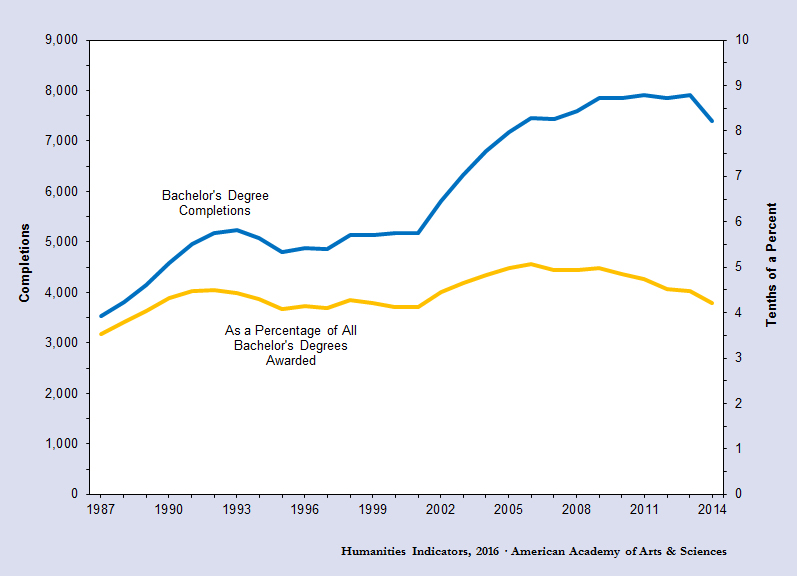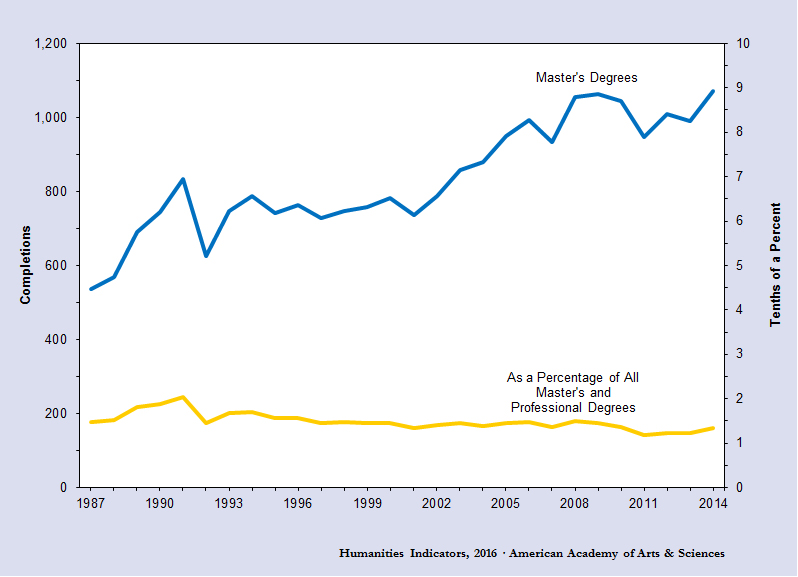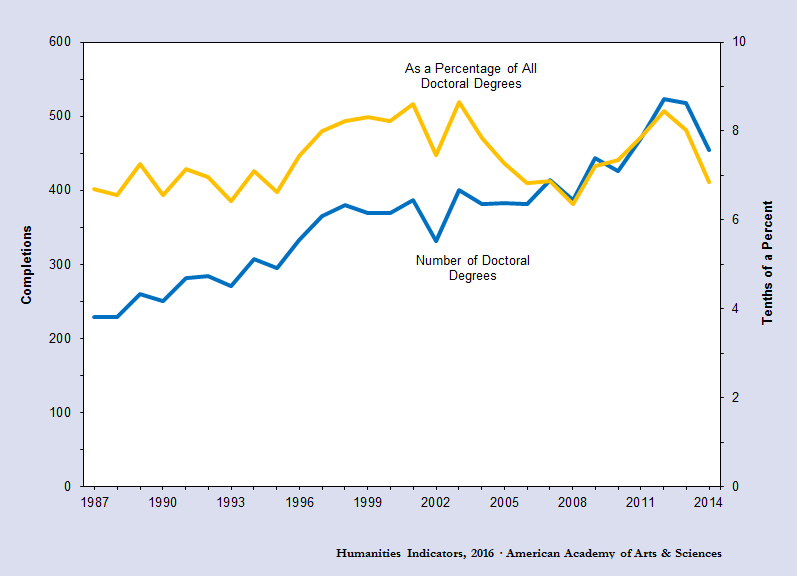Philosophy Degree Completions
- From 2013 to 2014, the number of philosophy bachelor’s degrees fell 6.6% (from 7,920 to 7,398 degrees), the largest decline in the 27 years for which data are available for the discipline (Indicator II-49a). Even after the drop, however, the number of philosophy bachelor’s degrees was still more than double the number conferred in 1987.
- In 2014, philosophy accounted for 0.42% of the approximately 1.7 million bachelor’s degrees conferred by U.S. institutions of higher learning. The share has been falling since 2006 (from a high of 0.51%).
- Master’s degree completions in philosophy approximately doubled from 1987 to 2009 (rising from 536 to 1,064), before briefly falling below 1,000 in 2011 and then rising to 1,071 degrees in 2014 (Indicator II-49b). Despite this growth, philosophy’s share of all master’s degrees fell over the last two decades (from a high of 0.20% in 1991 to 0.14% in 2014).
- The number of doctorates completed in philosophy grew incrementally from 1987 to the turn of the century, surged from 2008 to 2012, and then fell by more than 13% from 2012 to 2014 (Indicator II-49c). The 454 philosophy doctoral degrees conferred in 2014 was fewer than the 523 conferred in 2012 but still nearly twice the number of degrees conferred in 1987 (229).
- The number of doctoral degrees in philosophy briefly grew faster than the total number of doctorates, with the discipline’s share of all doctoral degrees rising from 0.67% in 1987 to 0.87% in the early 2000s. But subsequent growth in the number of doctorates conferred in all fields, and the drop in the number of philosophy degree completions from 2013 to 2014, brought the discipline’s share back down near the 1987 level (0.68%).
II-49a: Bachelor’s Degree Completions in Philosophy (Absolute Number and as a Percentage of All Bachelor’s Degrees), 1987–2014*

* Degree counts and shares do not include second majors.
Source: U.S. Department of Education, Institute of Education Sciences, National Center for Education Statistics, Integrated Postsecondary Education Data System (IPEDS). The IPEDS data were accessed and analyzed via the National Science Foundation’s online science and engineering resources data system, WebCASPAR.
See the Note on Data Used to Calculate Discipline-Specific Degree Counts and Shares. Unlike the other disciplines profiled in the HI, for which basic degree completion data are available going back to 1966, counts of philosophy degrees are available only from 1987 onward. (Until the late 1980s, philosophy degrees were combined by the National Center for Education Statistics, the collector of these data, with those conferred in religious studies.) See the Degree Program Code Catalog for an inventory of the specific degree programs included by the Humanities Indicators under the heading of “Philosophy”.
II-49b: Master’s Degree Completions in Philosophy (Absolute Number and as a Percentage of All Master’s and First Professional Degrees), 1987–2014

Source: U.S. Department of Education, Institute of Education Sciences, National Center for Education Statistics, Integrated Postsecondary Education Data System (IPEDS). The IPEDS data were accessed and analyzed via the National Science Foundation’s online science and engineering resources data system, WebCASPAR.
See the Note on Data Used to Calculate Discipline-Specific Degree Counts and Shares and the Note on the Definition of Advanced Degrees. Unlike the other disciplines profiled in the Humanities Indicators, for which basic degree completion data are available going back to 1966, counts of philosophy degrees are available only from 1987 onward. (Until the late 1980s, philosophy degrees were combined by the National Center for Education Statistics, the collector of these data, with those conferred in religious studies.) See the Degree Program Code Catalog for an inventory of the specific degree programs included by the Humanities Indicators under the heading of “Philosophy”.
II-49c: Doctoral Degree Completions in Philosophy (Absolute Number and as a Percentage of All Doctorates), 1987–2014

Source: U.S. Department of Education, Institute of Education Sciences, National Center for Education Statistics, Integrated Postsecondary Education Data System (IPEDS). The IPEDS data were accessed and analyzed via the National Science Foundation’s online science and engineering resources data system, WebCASPAR.
See the Note on Data Used to Calculate Discipline-Specific Degree Counts and Shares and the Note on the Definition of Advanced Degrees. Unlike the other disciplines profiled in the Humanities Indicators, for which basic degree completion data are available going back to 1966, counts of philosophy degrees are available only from 1987 onward. (Until the late 1980s, philosophy degrees were combined by the National Center for Education Statistics, the collector of these data, with those conferred in religious studies.) See the Degree Program Code Catalog for an inventory of the specific degree programs included by the Humanities Indicators under the heading of “Philosophy”.

